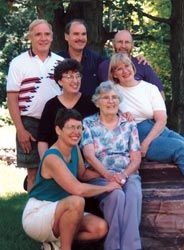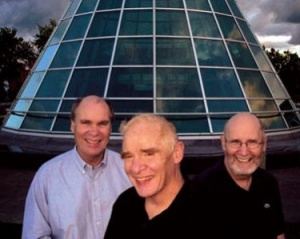Personal tools
Help
Tools
Class Notes
- Do you have news for fellow WSU alumni and other readers of Washington State Magazine? Send us your class note.
Our Story
written by alumni, faculty and friends.
NOTE: THIS IS A LEGACY SITE AND IS NOT REGULARLY MAINTAINED
Views
Maughan Brothers: grateful for a Mother's Influence
From Our Story
By Pat Caraher
From Washington State Magazine, Winter 2004/05
The brothers were honored by the WSU Alumni Association last May with individual alumni achievement awards. In a ceremony at the Lewis Alumni Centre, they were cited for their many accomplishments in engineering, science, and medicine, and for bringing recognition to their professions and alma mater.
Paul M. Maughan (’59 Mech. Engr.) is an authority in satellite remote sensing and multispectral information for natural resources and environmental applications. A pioneer in earth observations and global positioning systems (GPS), he was a founding partner of Space Development Services, 1984, and of Halcyon, Inc., 1992, both in Washington, D.C. He also was project manager for COMSAT and a consultant to NASA’s Stennis Space Center from 1987 to 2001. Several of his publications focus on planning an international consortium to design, launch, and operate a remote sensing system. He moved to Anacortes in 1993, where he remains active as a consultant.
David W. Maughan (’64 Physics) has been a research professor at the University of Vermont since 1974. He holds positions in the Molecular Physiology and Biophysics Department, the Cell and Molecular Biology Program, and the Biomedical Engineering Program. His home is in Burlington, Vermont.
Since 1977, W. Lowell Maughan, M.D. (’66 Zoology) has held 11 appointments at Johns Hopkins University School of Medicine. He currently is associate chief of cardiology at Johns Hopkins Hospital. He is also professor of medicine and biomedical engineering at John Hopkins University School of Medicine. He lives in Severna Park, Maryland.
The Maughans’ late parents were department chairs at WSU, Orlo in agricultural economics, Delight in foods and nutrition. Orlo was in line to be nominated for the position of U.S. undersecretary for agriculture, when a private plane he was piloting crashed at Fish Lake, Idaho, in 1947, killing him. Delight was a member of the faculty from 1948 until 1973, when she retired as department chair. She died in 2001 at age 90. Until shortly before her death, she made it a practice each Sunday afternoon to sit down at a computer and write a letter to her six children.

For more than 35 years, he contributed to many aspects of the use of remote sensing from space. For example, he participated in the design and development of satellite and information systems employing such convergent technologies as geographic information systems (GIS) and GPS in the technical analyses of spatial data, including earth-looking imagery from domestic and international weather and land satellite systems.
In one contract for NASA, he provided technical and administrative oversight for a project to monitor potato conditions and production on a 25,000-acre farm in Hermiston, Oregon, with center-pivot irrigation.
The common thread in his career has been his ability to synthesize technical, market, organizational, and financial factors by using advanced information systems tools to solve resource, environmental, and informational systems problems.
Jim Watson ’58, a Spokane financial consultant and a former classmate of Paul’s in mechanical engineering, says, “Paul seemed to understand what the professors were talking about. He read assignments before classes. He was a serious student.”
Among Paul’s favorite professors was Al Butler in physics. “He knew how to capture and inspire you to work your best,” he says.
David Maughan’s major research interests are in the areas of functional genomics and proteomics, with a focus in cellular and molecular physiology of striated muscle. He is currently involved in six major projects with the help of $4 million in grants, ranging from the molecular basis of flight in insects to investigations critical to human health, including the molecular basis of diabetic cardiomyopathy. His research has been published in Nature magazine. He has been awarded more than 20 grants for research from such agencies as the Washington State Heart Association, the Vermont Heart Association, the National Science Foundation, the Office of Naval Research, and the National Institutes of Health Muscular Dystrophy Association.
He received his Ph.D. in physiology and biophysics from the University of Washington in 1971, and conducted post-graduate research in physiology at the University of Bern, Switzerland, from 1971 to 1974. He has lectured and served as a consultant and visiting scholar in England, Japan, Germany, Switzerland, Italy, and China.
David remembers physics professors John Bender and Ed Donaldson, the latter of whom he recalls as “a young, dynamic professor . . . a role model in physics.” “I owe a lot to Sidney Hacker in mathematics,” he says. “He was instrumental in my getting a readership in astronomy from NSF and the keys to the WSU observatory.”
Henk Granzier, professor in Veterinary and Comparative Pharmacology and Physiology at WSU and a colleague at the University of Washington, saluted David for his “unusually high level of enthusiasm for scientific discovery . . . an enthusiasm that is contagious. He is kind and very supportive of young scientists.”
W. Lowell Maughan graduated from the UW School of Medicine with highest honors in 1970, trained in internal medicine at the University of California, San Diego, and Yale University, and in cardiology at Johns Hopkins University, where, incidentally, he earned an M.B.A. just two years ago. With each appointment, he has been able to use his expertise and skills in systems analysis, health, and human services to make wide-reaching advancements for Johns Hopkins Hospital and provide outreach to physicians nationally and internationally.
He has published 65 articles in medical journals, 19 books and book sections, and 90 abstracts, plus two video productions: The Cardiac Cycle: Clinical Physiology of the Normal Heart and Pressure-Volume Relationships of the Heart. He has served on the National Board of Medical Examiners and on the Veterans Administration Merit Review Board for Cardiovascular Studies.
Pullman physician Dave Spencer was Lowell’s classmate at both Pullman High School and the UW School of Medicine. “Lowell set high goals in med school and worked harder than everyone else to succeed,” he says. He remembers Lowell studying eight hours a day, and even rigging up a wire support in the bathtub so he could read his textbooks while bathing.
“I’ve always considered myself to be the underachiever in this group of Ph.D.s,” Lowell says of his brothers.
Not so, counters David. “I built an electrical control box with a switch to control everything in the room when I was growing up. Lowell tried to build one that would control my control box.”
At WSU Lowell came under the tutelage of zoologist Herbert Eastlick, advisor for all students seeking careers in the health care professions. “He had the highest standards for and expectations of his students,” Lowell says, citing zoologist Charles McNeill as another exacting professor. He also enjoyed Henry Grosshans’s History of Western Civilization course. “He taught it as history of thought,” Lowell says.
Two of the Maughans’ three sisters are also WSU alumni—Sally Kilpatrick (’59 Educ.), Anacortes, and Judy Busch (’69 Educ.), Seattle. The third, Patty Wixon, Ashland, Oregon, attended WSU before transferring to the University of Oregon, where she earned a degree in education administration and then a master’s degree at Reed College in Portland.
Speaking for his siblings, Paul says, “Any accomplishments we’ve had is because of our mother . . . a guiding light in all aspects of her life. We are so indebted to her.”
Our Story site map
Our Story main page | Our Story categories | Help Desk
Contact | Give | Advertise
Washington State Magazine | Washington State University | Class Notes
Our Story is coordinated by
In partnership with
Our Story and Washington State Magazine are publications of Washington State University. All rights reserved.
P.O. Box 641227, Washington State University, Pullman, WA 99164-1227 USA | wsm@wsu.edu, 509-335-2388
Accessibility | Copyright | Policies

